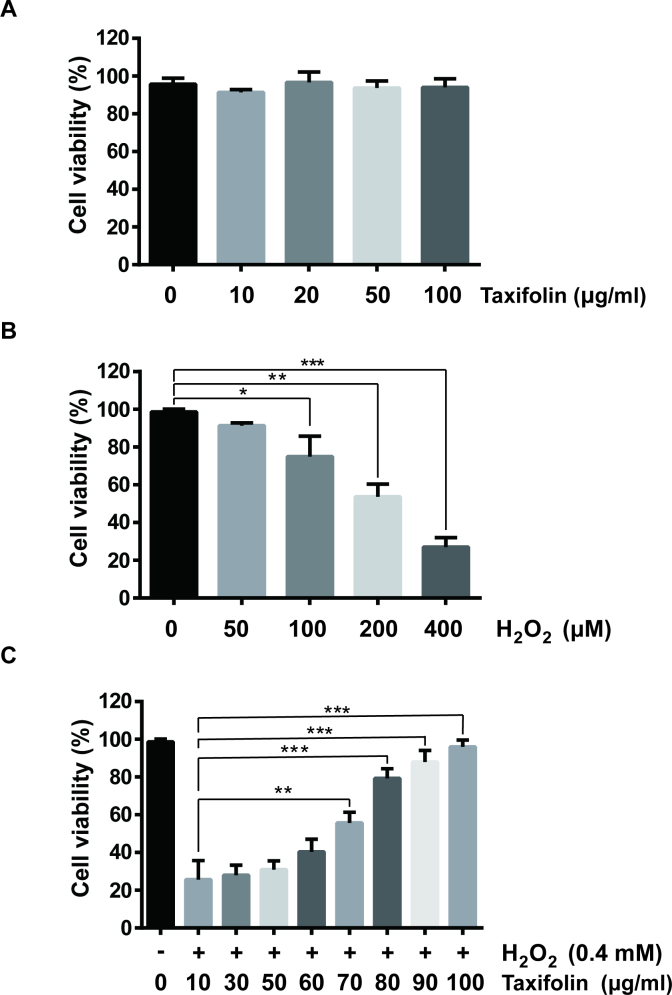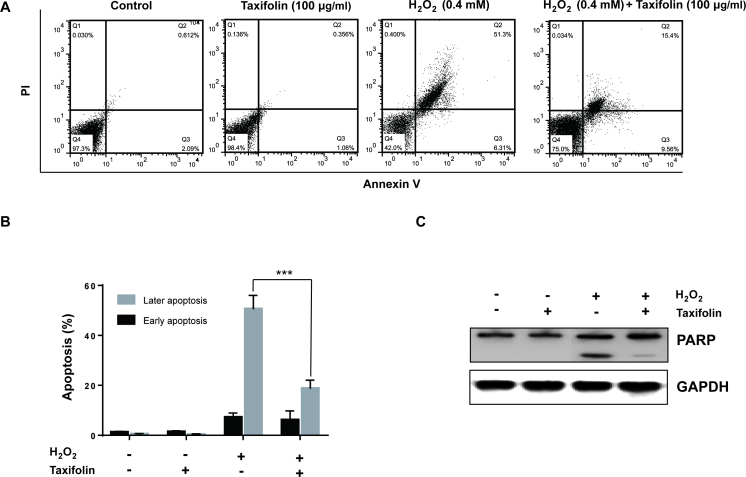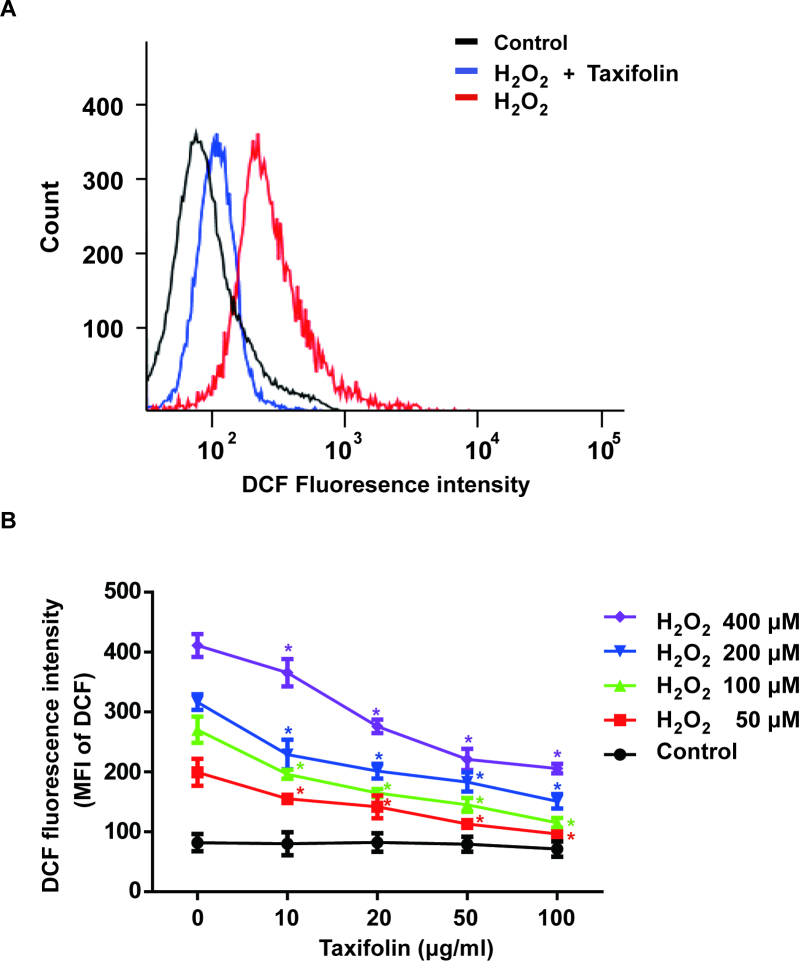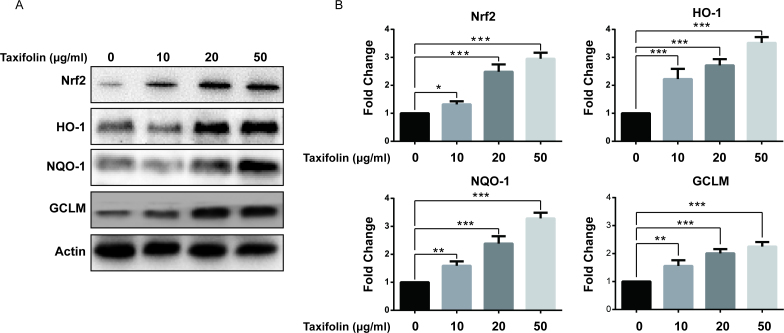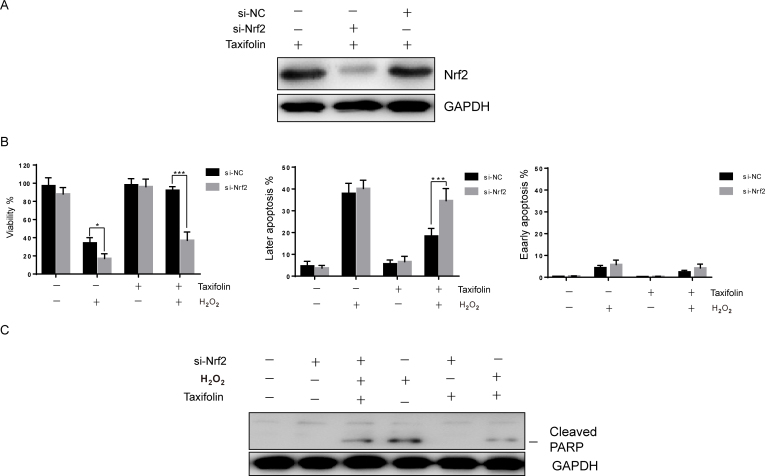Abstract
Purpose
Oxidative stress-induced damage to RPE cells has been suggested to be an important factor in the pathogenesis of age-related macular degeneration. Taxifolin, a flavonol, has been shown to exhibit significant antioxidant properties. The purpose of this study was to investigate the potential protective effects of taxifolin on RPE cells cultured under oxidative stress conditions and to elucidate the underlying mechanisms.
Methods
Human RPE (ARPE-19) cells were treated with different concentrations of taxifolin and 0.4 mM of H2O2 for 24 h. Cell viability was determined by the 3-(4,5-dimethylthiazol-2-yl)-2,5-diphenyltetrazolium bromide assay. Apoptosis was quantitatively measured by annexin V/propidium iodide double staining, and the expression levels of poly (ADP-ribose) polymerase (PARP) were evaluated by western blotting. Reactive oxygen species (ROS) were measured using a commercially available ROS detection system. The expressions of phase II enzymes, including NAD(P)H quinine oxidoreductase 1 (NQO1), heme oxygenase-1 (HO-1), and glutamate–cysteine ligase modifier (GCLM) and catalytic (GCLC) subunits, were examined using real-time PCR and western blotting. The nuclear localization of the nuclear factor (erythroid-derived 2)-like 2 (NRF2) protein was detected by western blotting.
Results: Taxifolin clearly inhibited the decrease in H2O2-induced cell viability, cell apoptosis, and intracellular ROS generation. In addition, taxifolin inhibited the H2O2-induced PARP cleavage. Moreover, treatment with taxifolin activated mRNA and the protein expression of NRF2 by inducing the translocation of NRF2 to the nucleus. Consequently, the mRNA and protein levels of the phase II enzymes NQO1, HO-1, GCLM, and GCLC increased.
Conclusions: Taxifolin was shown to protect RPE cells against oxidative stress-induced apoptosis. The potential mechanism appears to involve the activation of NRF2 and the phase II antioxidant enzyme system.
Introduction
Age-related macular degeneration (AMD) is a progressive eye disease caused by the degeneration of photoreceptors and adjacent RPE cells in the macula, the central portion of the retina. AMD is the leading cause of irreversible visual impairment and blindness among people aged 60 years and older [1,2]. It is a multifactorial late-onset disease, and oxidative stress-induced RPE cell damage is suggested to be an important factor of AMD [3-5]. Oxidative stress produces reactive oxygen species (ROS) and non-radical species, such as H2O2, which damage the cellular components of RPE cells, leading to apoptotic cell death [6-8]. Therefore, our studies have focused on methods for protecting RPE cells from oxidative stress-induced injury.
Taxifolin (3,5,7,3′,4′-pentahydroxy-flavanone or 2,3-dihydroquercetin), a type of flavonoid, is abundant in citrus fruits, grapes, olive oil, and onions [9-11]. As a common bioactive constituent of foods and herbs, taxifolin has been shown to exert a wide range of biochemical and pharmacological effects, including antitumor, anti-inflammatory, anti-diabetic, hepatoprotective, cardioprotective, and neuroprotective effects, and it contributes to the prevention of Alzheimer’s disease [12-20]. Importantly, taxifolin exerts significant antioxidant effects that are critical in preventing the onset of apoptosis [21]. Moreover, taxifolin has also been found to inhibit oxidative enzymes and the overproduction of ROS, thus ameliorating cerebral the ischemia–reperfusion injury [22].
However, the potential protective effects of taxifolin on AMD have not been studied. Therefore, in the present study, we investigated the cytoprotective effect of taxifolin on the oxidative stress induced by H2O2 in RPE cells and we explored the underlying mechanisms.
Methods
Cell culture and chemicals
The RPE cell line, ARPE-19, was obtained from the American Type Culture Collection (Manassas, VA, Appendix 1). The cells were maintained in Dulbecco’s modified Eagle’s medium (Gibco, Carlsbad, CA) containing 10% fetal bovine serum (FBS; HyClone, Logan, UT) at 37 °C in a humidified atmosphere of 5% CO2. Taxifolin, H2O2, 2′7′-dichlorodihydro-fluorescein diacetate (DCFDA), and all other routine chemicals were purchased from Sigma (St. Louis, MO).
Cell viability assays
The viability of cells was determined using 3-(4,5-dimethylthiazol-2-yl)-2,5-diphenyltetrazolium bromide (MTT) assays. Briefly, cells were plated at a density of 3 × 104 cells/well into 96-well plates. (This density leads to >90% confluence for 24 h). After 24 h of incubation, a fresh medium containing 10% FBS and 20 μl of an MTT solution (5 mg/ml) was added to each well. The plate was incubated for an additional 4 h at 37 °C, and absorbance was measured at 540 nm using a microwell plate reader (BioTek, Winooski, VT). Each individual measurement was repeated three times.
Apoptosis assay
Cells were stained using FITC Annexin V apoptosis detection kit (556,547, BD Biosciences, Franklin Lakes, NJ) according to the manufacturer’s instructions and they were subjected to analysis by flow cytometry (FACScan, Becton Dickinson, Franklin Lakes, NJ). The results are presented as the mean values from three independent determinations.
Measurement of cellular ROS
Intracellular ROS were measured by flow cytometry using a ROS detection kit (S0033, Beyotime, Shanghai, China). Briefly, cells were washed with phosphate-buffered saline (PBS) after treatment. Then, the cells were incubated with 15 μM DCFDA for 30 min at 37 °C. The cells were subsequently subjected to analysis using a FACSCalibur flow cytometer (BD Biosciences). Intracellular ROS levels are expressed as the mean DCFDA fluorescence intensity of the cells.
Western blotting assay
After treatment with taxifolin, cells were harvested by centrifugation. Cellular extracts were prepared by washing the cells with PBS and lysing them in a lysis buffer containing a protease inhibitor. Protein concentrations were measured using a BCA protein assay kit (P0009, Beyotime). Equal amounts of protein were loaded, separated by sodium dodecyl sulfate PAGE, and then transferred to a polyvinylidene difluoride membrane. After blocking with 5% milk for 1 h at room temperature, the membranes were incubated with primary antibodies, followed by incubation with horseradish peroxidase-conjugated secondary antibodies. The protein bands were visualized using an enhanced chemiluminescent substrate (Thermo Scientific, Rockford, IL).
RNA extraction and quantitative real-time PCR
Total RNA was extracted using the TRIzol reagent (Invitrogen, Carlsbad, CA) according to the manufacturer’s instructions. The amount and purity of total RNA were analyzed with an ultraviolet spectrophotometer at 260 nm. In addition, cDNA was reverse-transcribed from total RNA using the SuperScript III kit (12,574, Invitrogen). Quantitative real-time PCR was performed using an ABI PRISM 7000 fluorescent quantitative PCR system (Applied Biosystems, Foster City, CA). Each sample was measured in triplicate.
Silencing of Nrf2
Nrf2 levels were downregulated by transiently transfecting ARPE-19 cells with Nrf2 siRNA (5′-CACACTGGATCAGACAGGAGGATAT-3′; Genepharm, Shanghai) and Lipofectamine 2000 (Invitrogen) according to the manufacturer’s instructions. As a negative control, cells were transfected with negative control siRNA (si-NC; Genepharm). The efficiency of downregulation was evaluated by western blot.
Statistical analysis
All statistical analyses were performed using the SPSS 18.0 software (SPSS, Chicago, IL). Data from at least three independent experiments, each performed in triplicate, are presented as the mean ± standard deviation (SD). The significance of the differences between groups was estimated using the one-way ANOVA. Values were considered statistically significantly different when p<0.05.
Results
Taxifolin inhibits a decrease in hydrogen peroxide-induced RPE cell viability
To determine whether taxifolin has cytotoxic effects on human RPE cells, we incubated ARPE-19 cells with different concentrations of taxifolin alone for 24 h. Figure 1A shows there was no significant difference in cell viability between the non-treated and taxifolin-treated groups, even at a high concentration of taxifolin (100 μg/ml). H2O2 has been shown to model the oxidative damage to cells [23]. Therefore, we incubated ARPE-19 cells for 24 h with different concentrations of H2O2. Figure 1B shows that H2O2 dose-dependently reduced the viability of human ARPE-19 cells, with an especially strong inhibition observed at a high concentration (0.4 mM) of H2O2. Therefore, 0.4 mM H2O2 was used in the following experiments. As shown in Figure 1C, the viability of ARPE-19 cells significantly and dose-dependently increased when the cells were incubated with 0.4 mM H2O2 in the presence of different concentrations of taxifolin for 24 h. Together, these results demonstrate that taxifolin inhibits the H2O2-induced decrease in RPE cell viability in a dose-dependent manner.
Figure 1.
Taxifolin prevented the decrease in retinal pigment epithelial (RPE) cell viability induced by H2O2. A: ARPE-19 cells were incubated with different concentrations of taxifolin (0, 10, 20, 50, and 100 µg/ml) for 24 h. B: ARPE-19 cells were treated with different concentrations of H2O2 (0, 50, 100, 200, and 400 µM) for 24 h. C: ARPE-19 cells were treated with 0.4 mM H2O2 for 24 h in the presence of different concentrations of taxifolin. Data are shown as the mean ± SD (n = 3); *p<0.05, **p<0.01, and *** p<0.001.
Taxifolin inhibits hydrogen peroxide-induced RPE cell apoptosis
After we demonstrated that taxifolin inhibited the H2O2-induced decrease in ARPE-19 cell viability, we investigated whether apoptosis was involved in the process and whether taxifolin inhibited H2O2-induced apoptosis. We divided the ARPE-19 cells into four groups: a control group, taxifolin-treated group, H2O2 (0.4 mM)-treated group, and H2O2 (0.4 mM) plus taxifolin (100 μg/ml)-treated group. After incubation for 24 h, the four groups were stained with annexin V⁄ propidium iodide (PI), and flow cytometry was used to determine the apoptosis rate. Figure 2A, B shows that H2O2 (0.4 mM) induced ARPE-19 cell apoptosis, with more than 5% of cells showing early apoptotic signs (PI−/−and Annexin V+/+) and another 50% of cells showing late apoptotic signs (PI+/+, Annexin V+/+), while treatment with 100 μg/mL taxifolin inhibited the rate of ARPE-19 cell apoptosis. Further, Figure 2C shows that taxifolin decreased H2O2-induced poly (ADP-ribose) polymerase (PARP) cleavage. Meanwhile, there was no significant difference between the control and taxifolin (100 μg/ml)-treated groups. These results demonstrate that taxifolin inhibits H2O2-induced ARPE-19 cell apoptosis.
Figure 2.
Taxifolin inhibited H2O2-induced apoptosis in RPE cells. A: ARPE-19 cells were divided into four groups: a control group, taxifolin-treated group, H2O2 (0.4 mM)-treated group, and H2O2 (0.4 mM) plus taxifolin (100 μg/ml)-treated group. Flow cytometry recording shows the apoptosis rate of RPE cells. B: Quantitative data show the rate of apoptotic cells detected with flow cytometry. C: The expression levels of PARP cleavage were determined by western blot analysis. Data are shown as the mean ± SD (n = 3); *p<0.05, **p<0.01, and *** p<0.001.
Taxifolin inhibits hydrogen peroxide-induced ROS production
Next, we tested whether taxifolin affects H2O2-induced ROS production. ARPE-19 cells were divided into three groups: a control group, H2O2-treated group, and H2O2 plus taxifolin-treated group. After incubation for 24 h, we used DCFDA fluorescence to record the production of intracellular ROS. Figure 3A shows that taxifolin treatment inhibited dramatically the H2O2-induced ROS production in ARPE-19 cells. Moreover, Figure 3B shows that despite the increased concentrations of H2O2, taxifolin exhibited a dose-dependent inhibition of intracellular ROS production as determined by quantitative analysis.
Figure 3.
Taxifolin inhibited H2O2-induced intracellular generation of reactive oxygen species. A: ARPE-19 cells were divided into three groups, including a control group, H2O2-treated group, and H2O2 plus taxifolin-treated group. After incubation for 24 h, DCFDA fluorescence was used to record the production of intracellular ROS. B: Taxifolin reduced the generation of ROS in ARPE-19 cells significantly. Data are shown as the mean ± SD (n = 3); *p<0.05, **p<0.01, and *** p<0.001.
Taxifolin activates mRNA and the protein expressions of NRF2, HO-1, NQO1, and GCLM
As shown above, taxifolin protected ARPE-19 cells against oxidative stress by inhibiting H2O2-induced ROS production. It has been reported that the master transcriptional factor nuclear factor (erythroid-derived 2)-like 2 (NRF2) plays an important role in antioxidant responses and activates, in response to ROS, the expressions of cytoprotective genes, such as those encoding phase II enzymes [24]. To investigate the antioxidative mechanisms of taxifolin further, we determined the expression levels of NRF2, heme oxygenase-1 (HO-1), NAD(P)H quinine oxidoreductase 1 (NQO1), and the glutamate–cysteine ligase modifier (GCLM) and catalytic (GCLC) subunits. As shown in Figure 4A, treatment with taxifolin for 24 h upregulated the NRF2, HO-1, NQO1, and GCLM protein expressions in ARPE-19 cells in a dose-dependent manner. Figure 4B shows that the NRF2, HO-1, NQO1, and GCLM mRNA expressions were also significantly upregulated by taxifolin treatment for 24 h. These results suggest taxifolin protects ARPE-19 cells against oxidative stress by activating NQO1, HO-1, GCLC, and GCLM.
Figure 4.
Taxifolin increased mRNA and protein expression of nuclear factor (erythroid-derived 2)-like 2 (NRF2), heme oxygenase (HO)-1, NAD(P)H quinine oxidoreductase 1 (NQO1), and glutamate–cysteine ligase modifier (GCLM). A: Cells were treated with 10, 20, and 50 µM of taxifolin for 24 h. Western blot analysis was performed using the corresponding antibodies. B: Total RNA was extracted, and the amounts of NRF2, HO-1, NQO1, and GCLM mRNA were quantified with real-time PCR and normalized to the corresponding amounts of β-actin mRNA. Data are shown as mean ± SD (n = 3); *p<0.05, **p<0.01, and *** p<0.001.
Nrf2 mediates the taxifolin-induced RPE cytoprotective effect against H2O2
SiRNA was used to study whether taxifolin-induced Nrf2 activation protects cells from oxidative stress-induced apoptosis by H2O2. Nrf2 siRNA-treated cells showed significantly lower levels of Nrf2 compared to untreated cells and negative control siRNA (si-NC) transfected cells (Figure 5A). Under a non-stressed condition, the downregulation of Nrf2 leads to a slight decrease in cell viability. When cells were treated with H2O2, the silencing of Nrf2 had a much lower survival rate and higher apoptosis rate than si-NC transfected cells (Figure 5B). Furthermore, taxifolin’s decreasing of the H2O2-induced poly (ADP-ribose) polymerase (PARP) cleavage was also abolished after the silencing of Nrf2. These data indicate that taxifolin promotes cell survival via Nrf2 activation (Figure 5C).
Figure 5.
Nrf2 mediates taxifolin-induced cytoprotective effect against H2O2 in ARPE-19 cells. A: RPE cells transfected with si-Nrf2 or with si-NC in the presence of taxifolin. Western blot analysis was performed to measure the levels of Nrf2 using the corresponding antibodies. B: Cell viability and apoptosis were measured in ARPE-19 cells. C: Western blot analysis of cleaved PARP in ARPE-19 cells. Data are shown as the mean ± SD (n = 3); *p<0.05, **p<0.01, and *** p<0.001.
Discussion
AMD is one of the most important causes of blindness among the elderly [25], and oxidative stress has been suggested to play an important role in the pathophysiology of AMD [9]. Most risk factors for AMD, except genetic predisposition, such as an age above 65 years, cigarette smoking, obesity, exposure to blue light, and bright irises, lead to oxidative stress in the retina [26-28]. Additionally, oxidative stress is aggravated by the presence of lipofuscin [29]. Therefore, protecting RPE cells against oxidative damage is an important consideration for treating AMD. In this study, we found that taxifolin exhibited protective effects against oxidative damage in cultured ARPE-19 cells, which indicates its potential clinical significance as a new effective therapeutic treatment for AMD.
Taxifolin is a flavanonol derivative of flavonoids, which are abundant in foods and herbs [30]. It exhibits a wide range of bioactive effects, among which the antioxidant activity is quite distinct [9]. In the present study, we first revealed that taxifolin protected ARPE-19 cells against oxidative stress-induced apoptosis. We adopted a classical model, which includes the addition of H2O2 to cultured cells, to test the susceptibility of ARPE-19 cells to oxidative stress and the antioxidant efficacy of taxifolin and we demonstrated that H2O2 induced a decrease in the viability of ARPE-19 cells. However, treatment with taxifolin inhibited a decrease in cell viability in a dose-dependent manner. It has been reported that oxidative stress plays an important role in cell apoptosis [31,32]. In this study, we found that H2O2 induced ARPE-19 cell apoptosis, which was inhibited by treatment with taxifolin. In addition, we detected the cleavage of PARP, which is often associated with apoptosis and has served as one of the hallmarks of apoptosis and caspase activation [33]. Western blot analysis showed that taxifolin decreased the H2O2-induced PARP cleavage. Moreover, using DCFDA fluorescence, we detected that taxifolin inhibited the H2O2-induced intracellular generation of ROS. Consequently, these results demonstrate that taxifolin protects ARPE-19 cells from H2O2-induced cell damage via its anti-apoptotic and antioxidative effects.
We investigated further the potential antioxidative mechanisms of taxifolin. It has been reported that the master transcriptional factor NRF2 activates the expressions of cytoprotective genes in response to ROS and attenuates oxidative stress [34-36]. In a dormant state, NRF2 is subjected to ubiquitin-mediated proteasomal degradation through interactions with its component, Kelch-like epichlorohydrin (ECH)-associated protein 1 (KEAP1) [37]. Upon activation by oxidative stimuli, NRF2 dissociates from KEAP1 and then translocates to the nucleus, where it activates the transcription of target genes and upregulates the levels of phase II defense enzymes, such as HO-1, NQO1, and GCLM [38-41]. In addition, studies have shown that taxifolin upregulated the NRF2 pathway to curb the nuclear factor-κB-mediated Wnt/β-catenin signaling in colon carcinogenesis [42]. In this study, we investigated whether taxifolin targets the NRF2 pathway and promotes the expression of phase II enzymes in ARPE-19 cells. The western blot results showed that treatment with taxifolin increased the protein levels and mRNA expressions of NRF2, HO-1, NQO1, and GCLM in a dose-dependent manner. In addition, we found that ARPE-19 cells died despite taxifolin treatment after the downregulation of Nrf2 in the presence of H2O2. Therefore, these results suggested that the protective effects of taxifolin likely involve the upregulation of NRF2 and the enhancement of the phase II antioxidant enzyme system.
In conclusion, the present study revealed a novel function of taxifolin, to protect RPE cells against oxidative stress by inhibiting the H2O2-induced decrease in cell viability, cell apoptosis, and the intracellular generation of ROS. The potential mechanism appears to involve the activation of NRF2 and the upregulation of the phase II antioxidant enzyme system. Our results provide important information on taxifolin as a potential therapeutic agent for the prevention and therapy of AMD.
Acknowledgments
This study was supported by a grant from China Postdoctoral Science Foundation (2015M571241). The authors confirm that there are no known conflicts of interest associated with this publication and there has been no significant financial support for this work that could have influenced its outcome.
Appendix 1. STR analysis
To access these data, click or select the words "Appendix 1".
References
- 1.Woo JM, Shin DY, Lee SJ, Joe Y, Zheng M, Yim JH, Callaway Z, Chung HT. Curcumin protects retinal pigment epithelial cells against oxidative stress via induction of heme oxygenase-1 expression and reduction of reactive oxygen. Mol Vis. 2012;18:901–8. [PMC free article] [PubMed] [Google Scholar]
- 2.Seddon JM, George S, Rosner B, Rifai N. Progression of age-related macular degeneration: prospective assessment of C-reactive protein, interleukin 6, and other cardiovascular biomarkers. Arch Ophthalmol. 2005;123:774–82. doi: 10.1001/archopht.123.6.774. [DOI] [PubMed] [Google Scholar]
- 3.Shaw PX, Stiles T, Douglas C, Ho D, Fan W, Du H, Xiao X. Oxidative stress, innate immunity, and age-related macular degeneration. AIMS Mol Sci. 2016;3:196–221. doi: 10.3934/molsci.2016.2.196. [DOI] [PMC free article] [PubMed] [Google Scholar]
- 4.Yildirim Z, Ucgun NI, Yildirim F. The role of oxidative stress and antioxidants in the pathogenesis of age-related macular degeneration. Clinics (Sao Paulo, Brazil) 2011;66:743–6. doi: 10.1590/S1807-59322011000500006. [DOI] [PMC free article] [PubMed] [Google Scholar]
- 5.Drobek-Slowik M, Karczewicz D, Safranow K. The potential role of oxidative stress in the pathogenesis of the age-related macular degeneration (AMD). Postepy Hig Med Dosw (Online) 2007;61:28–37. [PubMed] [Google Scholar]
- 6.van Lookeren Campagne M, LeCouter J, Yaspan BL, Ye W. Mechanisms of age-related macular degeneration and therapeutic opportunities. J Pathol. 2014;232:151–64. doi: 10.1002/path.4266. [DOI] [PubMed] [Google Scholar]
- 7.Li KR, Yang SQ, Gong YQ, Yang H, Li XM, Zhao YX, Yao J, Jiang Q, Cao C. 3H–1,2-dithiole-3-thione protects retinal pigment epithelium cells against Ultra-violet radiation via activation of Akt-mTORC1-dependent Nrf2-HO-1 signaling. Sci Rep. 2016;6:25525. doi: 10.1038/srep25525. [DOI] [PMC free article] [PubMed] [Google Scholar]
- 8.Valko M, Rhodes CJ, Moncol J, Izakovic M, Mazur M. Free radicals, metals and antioxidants in oxidative stress-induced cancer. Chem Biol Interact. 2006;160:1–40. doi: 10.1016/j.cbi.2005.12.009. [DOI] [PubMed] [Google Scholar]
- 9.Topal F, Nar M, Gocer H, Kalin P, Kocyigit UM, Gülçin İ, Alwasel SH. Antioxidant activity of taxifolin: an activity–structure relationship. J Enzyme Inhib Med Chem. 2015;•••:1–10. doi: 10.3109/14756366.2015.1057723. [DOI] [PubMed] [Google Scholar]
- 10.Schauss AG, Tselyico SS, Kuznetsova VA, Yegorova I. Toxicological and Genotoxicity Assessment of a Dihydroquercetin-Rich Dahurian Larch Tree (Larix gmelinii Rupr) Extract (Lavitol). Int J Toxicol. 2015;•••:1091581815576975. doi: 10.1177/1091581815576975. [DOI] [PubMed] [Google Scholar]
- 11.Slimestad R, Fossen T, Vågen IM. Onions: a source of unique dietary flavonoids. J Agric Food Chem. 2007;55:10067–80. doi: 10.1021/jf0712503. [DOI] [PubMed] [Google Scholar]
- 12.Oi N, Chen H, Kim MO, Lubet RA, Bode AM, Dong Z. Taxifolin suppresses UV-induced skin carcinogenesis by targeting EGFR and PI3K. Cancer Prev Res (Phila) 2012;5:1103–14. doi: 10.1158/1940-6207.CAPR-11-0397. [DOI] [PMC free article] [PubMed] [Google Scholar]
- 13.Gupta M, Bhalla T, Gupta G, Mitra C, Bhargava K. Anti-inflammatory activity of taxifolin. Jpn J Pharmacol. 1971;21:377–82. doi: 10.1254/jjp.21.377. [DOI] [PubMed] [Google Scholar]
- 14.Sun X, Chen R-c, Yang Z-h, Sun G-b, Wang M, Ma X-j, Yang L-j, Sun X-b. Taxifolin prevents diabetic cardiomyopathy in vivo and in vitro by inhibition of oxidative stress and cell apoptosis. Food Chem Toxicol. 2014;63:221–32. doi: 10.1016/j.fct.2013.11.013. [DOI] [PubMed] [Google Scholar]
- 15.Gocer H, Topal F, Topal M, Kucuk M, Teke D, Gulcin I, Alwasel SH, Supuran CT. Acetylcholinesterase and carbonic anhydrase isoenzymes I and II inhibition profiles of taxifolin. J Enzyme Inhib Med Chem. 2016;31:441–7. doi: 10.3109/14756366.2015.1036051. [DOI] [PubMed] [Google Scholar]
- 16.Zhao M, Chen J, Zhu P, Fujino M, Takahara T, Toyama S, Tomita A, Zhao L, Yang Z, Hei M, Zhong L, Zhuang J, Kimura S, Li XK. Dihydroquercetin (DHQ) ameliorated concanavalin A-induced mouse experimental fulminant hepatitis and enhanced HO-1 expression through MAPK/Nrf2 antioxidant pathway in RAW cells. Int Immunopharmacol. 2015;28:938–44. doi: 10.1016/j.intimp.2015.04.032. [DOI] [PubMed] [Google Scholar]
- 17.Guo H, Zhang X, Cui Y, Zhou H, Xu D, Shan T, Zhang F, Guo Y, Chen Y, Wu D. Taxifolin protects against cardiac hypertrophy and fibrosis during biomechanical stress of pressure overload. Toxicol Appl Pharmacol. 2015;287:168–77. doi: 10.1016/j.taap.2015.06.002. [DOI] [PubMed] [Google Scholar]
- 18.Dok-Go H, Lee KH, Kim HJ, Lee EH, Lee J, Song YS, Lee Y-H, Jin C, Lee YS, Cho J. Neuroprotective effects of antioxidative flavonoids, quercetin,(+)-dihydroquercetin and quercetin 3-methyl ether, isolated from Opuntia ficus-indica var. saboten. Brain Res. 2003;965:130–6. doi: 10.1016/s0006-8993(02)04150-1. [DOI] [PubMed] [Google Scholar]
- 19.Wang YH, Wang WY, Chang CC, Liou KT, Sung YJ, Liao JF, Chen CF, Chang S, Hou YC, Chou YC, Shen YC. Taxifolin ameliorates cerebral ischemia-reperfusion injury in rats through its anti-oxidative effect and modulation of NF-kappa B activation. J Biomed Sci. 2006;13:127–41. doi: 10.1007/s11373-005-9031-0. [DOI] [PubMed] [Google Scholar]
- 20.Manigandan K, Manimaran D, Jayaraj RL, Elangovan N, Dhivya V, Kaphle A. Taxifolin curbs NF-kappaB-mediated Wnt/beta-catenin signaling via up-regulating Nrf2 pathway in experimental colon carcinogenesis. Biochimie. 2015;119:103–12. doi: 10.1016/j.biochi.2015.10.014. [DOI] [PubMed] [Google Scholar]
- 21.Vladimirov YA, Proskurnina EV, Demin EM, Matveeva NS, Lubitskiy OB, Novikov AA, Izmailov DY, Osipov AN, Tikhonov VP, Kagan VE. Dihydroquercetin (taxifolin) and other flavonoids as inhibitors of free radical formation at key stages of apoptosis. Biochemistry (Mosc) 2009;74:301–7. doi: 10.1134/s0006297909030092. [DOI] [PubMed] [Google Scholar]
- 22.Voulgari C, Papadogiannis D, Tentolouris N. Diabetic cardiomyopathy: from the pathophysiology of the cardiac myocytes to current diagnosis and management strategies. Vasc Health Risk Manag. 2010;6:883–903. doi: 10.2147/VHRM.S11681. [DOI] [PMC free article] [PubMed] [Google Scholar]
- 23.Kaczara P, Sarna T, Burke JM. Dynamics of H 2 O 2 availability to ARPE-19 cultures in models of oxidative stress. Free Radic Biol Med. 2010;48:1064–70. doi: 10.1016/j.freeradbiomed.2010.01.022. [DOI] [PMC free article] [PubMed] [Google Scholar]
- 24.Nguyen T, Yang CS, Pickett CB. The pathways and molecular mechanisms regulating Nrf2 activation in response to chemical stress. Free Radic Biol Med. 2004;37:433–41. doi: 10.1016/j.freeradbiomed.2004.04.033. [DOI] [PubMed] [Google Scholar]
- 25.Friedman DS, O’Colmain BJ, Munoz B, Tomany SC, McCarty C, de Jong PT, Nemesure B, Mitchell P, Kempen J. Prevalence of age-related macular degeneration in the United States. Arch Ophthalmol. 2004;122:564–72. doi: 10.1001/archopht.122.4.564. [DOI] [PubMed] [Google Scholar]
- 26.Bowes Rickman C, Farsiu S, Toth CA, Klingeborn M. Dry age-related macular degeneration: mechanisms, therapeutic targets, and imaging. Invest Ophthalmol Vis Sci. 2013;54:Orsf68–80. doi: 10.1167/iovs.13-12757. [DOI] [PMC free article] [PubMed] [Google Scholar]
- 27.Hanus J, Kolkin A, Chimienti J, Botsay S, Wang S. 4-Acetoxyphenol Prevents RPE Oxidative Stress-Induced Necrosis by Functioning as an NRF2 Stabilizer. Invest Ophthalmol Vis Sci. 2015;56:5048–59. doi: 10.1167/iovs.15-16401. [DOI] [PMC free article] [PubMed] [Google Scholar]
- 28.Chew EY, Clemons TE, Agrón E, Sperduto RD, SanGiovanni JP, Davis MD, Ferris FL. Ten-year follow-up of age-related macular degeneration in the age-related eye disease study: AREDS report no. 36. JAMA Ophthalmol. 2014;132:272–7. doi: 10.1001/jamaophthalmol.2013.6636. [DOI] [PMC free article] [PubMed] [Google Scholar]
- 29.Drobek-Slowik M, Karczewicz D, Safranow K. The potential role of oxidative stress in the pathogenesis of the age-related macular degeneration (AMD). Postepy Hig Med Dosw (Online) 2007;61:28–37. [PubMed] [Google Scholar]
- 30.Su J, Shi HX, Wang LJ, Guo RX, Ren TK, Wu YB. [Chemical constituents of bark of Taxus chinensis var. mairei]. Zhong yao cai = Zhongyaocai = Zhong Yao Cai. 2014;37:243–51. [PubMed] [Google Scholar]
- 31.Khullar M, Al-Shudiefat AA-RS, Ludke A, Binepal G, Singal PK. Oxidative stress: a key contributor to diabetic cardiomyopathy This review is one of a selection of papers published in a Special Issue on Oxidative Stress in Health and Disease. Can J Physiol Pharmacol. 2010;88:233–40. doi: 10.1139/Y10-016. [DOI] [PubMed] [Google Scholar]
- 32.Jung Y-H, Heo J, Lee YJ, Kwon TK, Kim Y-H. Quercetin enhances TRAIL-induced apoptosis in prostate cancer cells via increased protein stability of death receptor 5. Life Sci. 2010;86:351–7. doi: 10.1016/j.lfs.2010.01.008. [DOI] [PMC free article] [PubMed] [Google Scholar]
- 33.Fang Y, Yu Y, Hou Q, Zheng X, Zhang M, Zhang D, Li J, Wu X-R, Huang C. The Chinese herb isolate isorhapontigenin induces apoptosis in human cancer cells by down-regulating overexpression of antiapoptotic protein XIAP. J Biol Chem. 2012;287:35234–43. doi: 10.1074/jbc.M112.389494. [DOI] [PMC free article] [PubMed] [Google Scholar]
- 34.Kaspar JW, Niture SK, Jaiswal AK. Nrf2: INrf2 (Keap1) signaling in oxidative stress. Free Radic Biol Med. 2009;47:1304–9. doi: 10.1016/j.freeradbiomed.2009.07.035. [DOI] [PMC free article] [PubMed] [Google Scholar]
- 35.Nguyen T, Yang CS, Pickett CB. The pathways and molecular mechanisms regulating Nrf2 activation in response to chemical stress. Free Radic Biol Med. 2004;37:433–41. doi: 10.1016/j.freeradbiomed.2004.04.033. [DOI] [PubMed] [Google Scholar]
- 36.Kwak M-K, Itoh K, Yamamoto M, Sutter TR, Kensler TW. Role of transcription factor Nrf2 in the induction of hepatic phase 2 and antioxidative enzymes in vivo by the cancer chemoprotective agent, 3H–1, 2-dimethiole-3-thione. Mol Med. 2001;7:135. [PMC free article] [PubMed] [Google Scholar]
- 37.Ma Q, He X. Molecular basis of electrophilic and oxidative defense: promises and perils of Nrf2. Pharmacol Rev. 2012;64:1055–81. doi: 10.1124/pr.110.004333. [DOI] [PMC free article] [PubMed] [Google Scholar]
- 38.Baird L, Dinkova-Kostova AT. The cytoprotective role of the Keap1–Nrf2 pathway. Arch Toxicol. 2011;85:241–72. doi: 10.1007/s00204-011-0674-5. [DOI] [PubMed] [Google Scholar]
- 39.Osburn WO, Wakabayashi N, Misra V, Nilles T, Biswal S, Trush MA, Kensler TW. Nrf2 regulates an adaptive response protecting against oxidative damage following diquat-mediated formation of superoxide anion. Arch Biochem Biophys. 2006;454:7–15. doi: 10.1016/j.abb.2006.08.005. [DOI] [PMC free article] [PubMed] [Google Scholar]
- 40.Li W, Kong AN. Molecular mechanisms of Nrf2‐mediated antioxidant response. Mol Carcinog. 2009;48:91–104. doi: 10.1002/mc.20465. [DOI] [PMC free article] [PubMed] [Google Scholar]
- 41.Kim KC, Kang KA, Zhang R, Piao MJ, Kim GY, Kang MY, Lee SJ, Lee NH, Surh Y-J, Hyun JW. Up-regulation of Nrf2-mediated heme oxygenase-1 expression by eckol, a phlorotannin compound, through activation of Erk and PI3K/Akt. Int J Biochem Cell Biol. 2010;42:297–305. doi: 10.1016/j.biocel.2009.11.009. [DOI] [PubMed] [Google Scholar]
- 42.Manigandan K, Manimaran D, Jayaraj RL, Elangovan N, Dhivya V, Kaphle A. Taxifolin curbs NF-κB-mediated Wnt/β-catenin signaling via up-regulating Nrf2 pathway in experimental colon carcinogenesis. Biochimie. 2015;119:103–12. doi: 10.1016/j.biochi.2015.10.014. [DOI] [PubMed] [Google Scholar]



